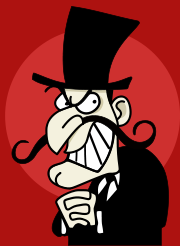What's up with all the evil?

I think I have a problem. Not a really bad problem like, you know, cancer. But a problem nonetheless.
I am addicted to evil characters.
There, I said it. It became clear to me last night while watching the return of Alias (Did everyone know that Irina is back? Because I kind of forgot and then BAM! Hotness!) that I am far more invested in the evil or morally compromised characters than the white hats. Okay, it’s nice that Agent Weiss has apparently done well for himself and that Vaughn is apparently alive and all, but. . .hey! Tom Grace might be working both sides? Irina’s been using Syd all along? Yes! More, more, more!
Ahem.
This got me thinking. What goes into a really good villain—the kind of twisted, sadistic bastard you just love to hate? My spychick MS is the first time I’ve really sat down to create a larger-than-life villain who has enough gusto to last through what I hope will be several installments, and it was harder than I thought. You can’t give away too much about a villain, not at first anyway. If his motives are crystal clear, he’s just evil and not intriguingly evil. But at the same time, you have to hook a reader’s interest in what made him intriguingly evil and so there has to be some sort of backstory to him (or her).
Take one of my all-time favorite villains: the above-mentioned, awesomely hot and almost always eeeevil Irina Derevko of Alias fame. I’ve faded in and out as an Alias fan over the years, but one hint of an Irina appearance and I am parked on the couch rubbing my hands in gleeful anticipation. The key here is that she is a complex character with more layers than a five-pound onion. She evil! She’s misunderstood! She was forced to betray her husband and daughter! She’s always been working toward her own endgame! We never know what to think, and yet we always want to know more. It’s taken four seasons (okay, so she wasn’t actually in season three but she’s always lurking, even when she’s off-screen) to peel back her mystery and reveal. . .more mystery. Yet along the way the viewers have been given enough crumbs to make us sympathetic to the woman who has quite possibly been playing all of the white hats for fools all along. That is one masterfully-drawn villain.
In the case of my story, it’s told from the heroines POV and she has precious little information about the villain. Her CIA masters (some of whom are less evil villains) may or may not have more, but they’re not telling—yet. So I had to come up with some other way of making the reader care what happens to him and ended up working in a tie to a future plotline that is just hinted at in this book. The reader, like the heroine, might just as well want him dead but if that happens he’ll never have a chance to elaborate on what he knows. Mwahaha—
Sorry.
There’s no secret formula for a good villain, just as there is no formula for a good hero. Character development is not a science, no matter what all those books on writing would have you think. But just like a main character, a villain is a key part of the story and can either advance it naturally or simply appear as a one-dimensional plot device.
Bottom line? Write me a good villain and I’m yours forever. Or at least until I find a good therapist.

2 Comments:
Melanie,
I've enjoyed reading over your blog. I have linked it to my page own blog, which is about the experience of a first time Australian novelist
http://geoffreygates.blogspot.com/
Regards,
Geoff
ACK! Alias spoilers... ack. I'm only in season 2 on DVD.
*deep breath* It's ok. I scrolled past quickly.
Post a Comment
<< Home